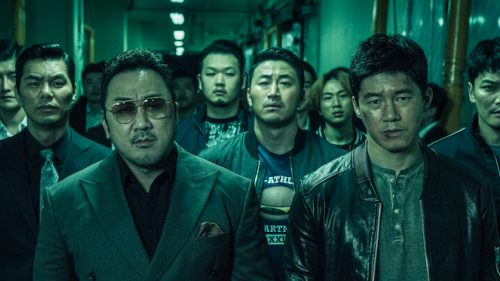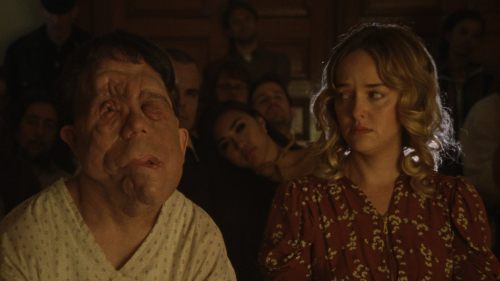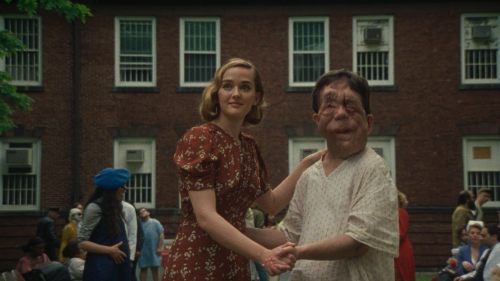Fantasia 2018: CHAINED FOR LIFE Charms And Challenges
Hollywood has never been particularly empathetic in its treatment of the disabled and disfigured. Whether treated as circus-style (or literal circus) oddities, monsters, objects of pity, or acting challenges for able-bodied people, the disabled are rarely given the dignity of telling stories about anything other than their disability. Sometimes it’s well-meaning; sometimes it's exploitative; rarely if ever is it really satisfactory.
Chained For Life, by Go Down Death director Aaron Schimberg (himself born with a bilateral cleft palate, and a patient in over 70 reconstructive surgeries), feels almost like an essay on this phenomenon. At least, it would, if it weren't so dramatically and visually enthralling. Chained For Life is jam-packed with ideas, exploring its themes from every potential angle, and managing to thrill, move, and engage, in the process.
The two lead actors in Chained For Life - Teeth’s Jess Weixler and Under the Skin’s Adam Pearson (who has neurofibromatosis) - play actors Mabel and Rosenthal on a horror-drama film set run by an eccentric European director. Within that film, they play a pretty blind girl in a hospital for the deformed, and the disfigured man with whom she falls in love (then shuns when she regains her sight). Outside it, Mabel and Rosenthal develop a friendship that, while never going as far as the relationship they’re performing, brings them to a quiet, if partial, understanding.
The ideas in this film branch out from the film within the film. A portmanteau of all the ways Hollywood has depicted the disfigured, it’s shocking not just for how many cliches it hits, but for how plausible it feels as a horror movie. From its Mask- and Elephant Man-adjacent premise, to the eugenics-adjacent German period setting, the Freaks-adjacent cast, and even the leering, othering camerawork, it does it all. One scene in particular, in which Rosenthal is directed to step out of the shadows and reveal his face, is laid hilariously and squirm-inducingly bare, as we watch take after take of the Herzogian director trying to guide his performance without admitting the ghoulishly voyeuristic nature of the shot.
But the bulk of the movie takes place in the real world of actors and crew, and it’s there that Chained For Life becomes an intoxicating whirlwind of ideas. Weixler and Pearson are excellent in the two lead roles, navigating all the self-reflective beats the script asks them to hit, while the rest of the cast deliver memorable performances even without, in some cases, saying a line.
Mabel and Rosenthal’s story together is as touching as it is uncomfortable - but it’s the Altman-style overlapping narratives that really demonstrate Chained For Life’s brilliance. In conversation and action, we’re given an almost overwhelming picture of the place of the disfigured within cinema. Characters discuss actors’ transformative powers, namechecking Daniel Day-Lewis' faux-cerebral palsy from My Left Foot and Orson Welles’ Othello blackface. The able-bodied actors deliver all manner of patronising condescension to their disabled co-stars - never outright cruel, but always displaying subtle, insidious prejudice - while trading between themselves methods of looking even more beautiful. And throughout, there’s a simmering subplot of the police looking for a murder suspect only referred to as having “distinctive facial characteristics.”
And then! Chained For Life takes another turn, as the disabled cast members - banished to sleep on set, in an abandoned hospital next to a breast enlargement clinic (!) - start making their own film. Here, Schimberg delves into a wildly meta realm. The lines between actor and character become blurred, various levels of reality, fantasy, and filmmaking blending together, leading up to a tantalisingly opaque series of alternate endings - all filmed on beautiful, grainy film stock that only highlights the artifice of it all. Oooooh, there’s a lot to dig into in this movie. I love it.
There’s no getting around the fact that while Chained For Life is something of a treatise on the way cinema treats the disfigured, it’s also a movie featuring disfigured actors - making it as much a sibling to Freaks’ ilk as it is a response to it. But Schimberg, as you’d expect, is aware of this, as his ever-deepening layers of meta-commentary demonstrate. Chained For Life almost dares you to judge it - and welcomes criticisms. The film is about how Hollywood isn’t “there” yet with regards to representation, and it all but explicitly states that even this movie doesn’t have the answers.
Despite taking place on a movie set, Chained For Life is unlike most films about filmmaking. This isn’t about the creative process, or art versus commerce, or a self-indulgent inside joke. Hyper-literate and self-aware, it’s an incisive film about prejudice and representation, referring to and critiquing Hollywood history (it takes its very title from a 1952 exploitation film about Siamese twins) while making its own observations and telling its own story. Clearly, this was a highly personal work for Schimberg, and he’s absolutely achieved his goals with this spectacularly moving and entertaining feature.
If you extend its thematic ideas outward, as the film itself does on occasion, Chained For Life could be a defining film about representation not just for the disabled, but for any group that Hollywood marginalises. It’s full of questions about representation, empathy, the nature of beauty, the values of cinema, and more - and crucially, never pretends to answer them. You’ll likely come away from it, as I did, acutely aware of your own unacknowledged prejudices - but that’s good. And the movie’s great.



